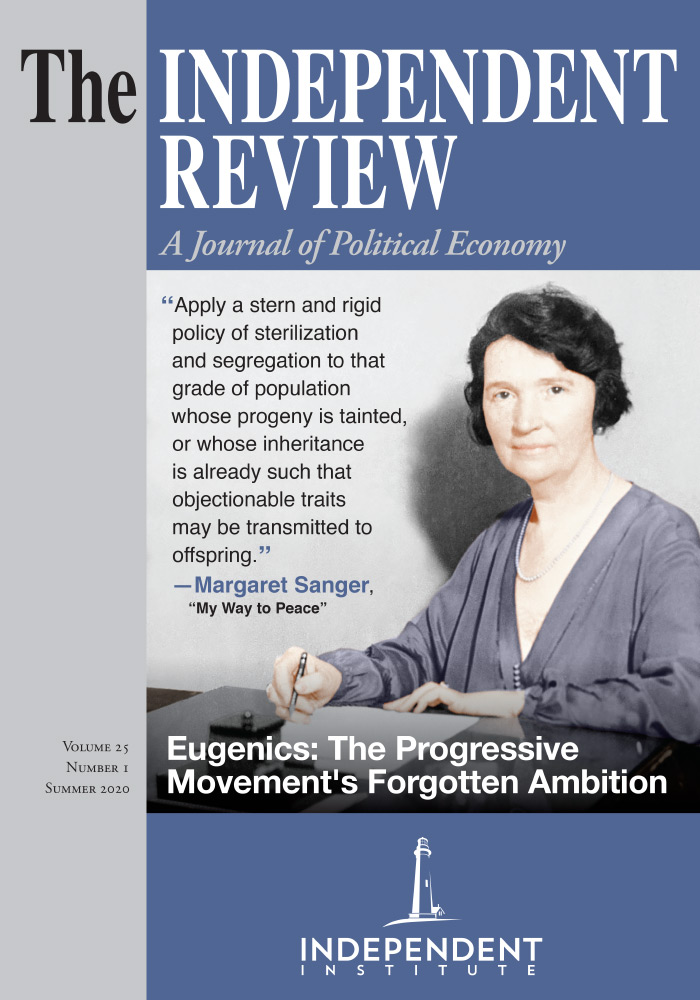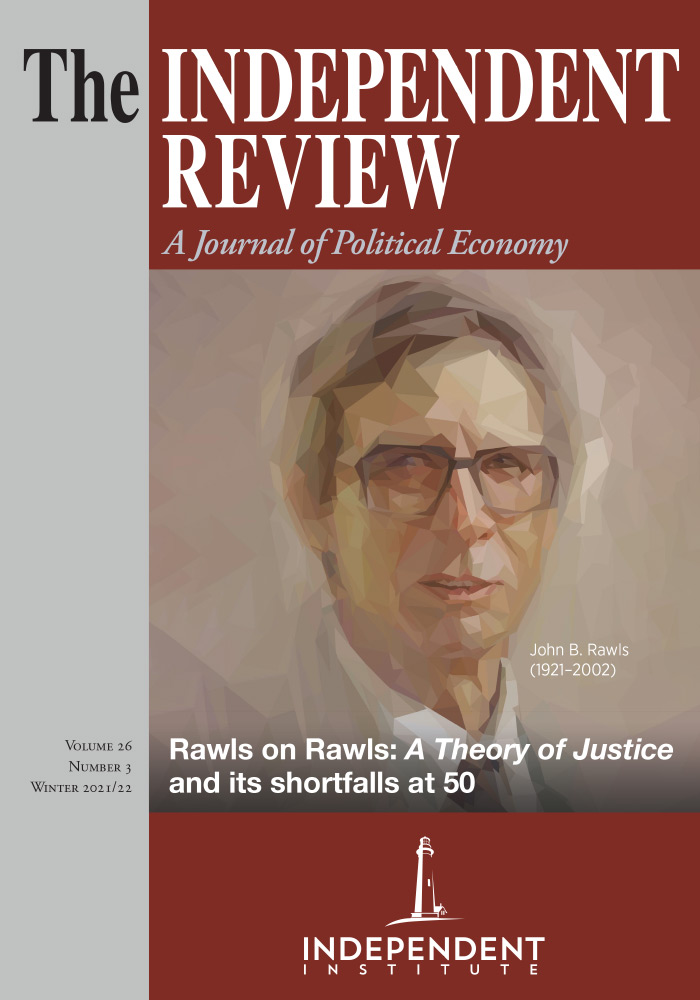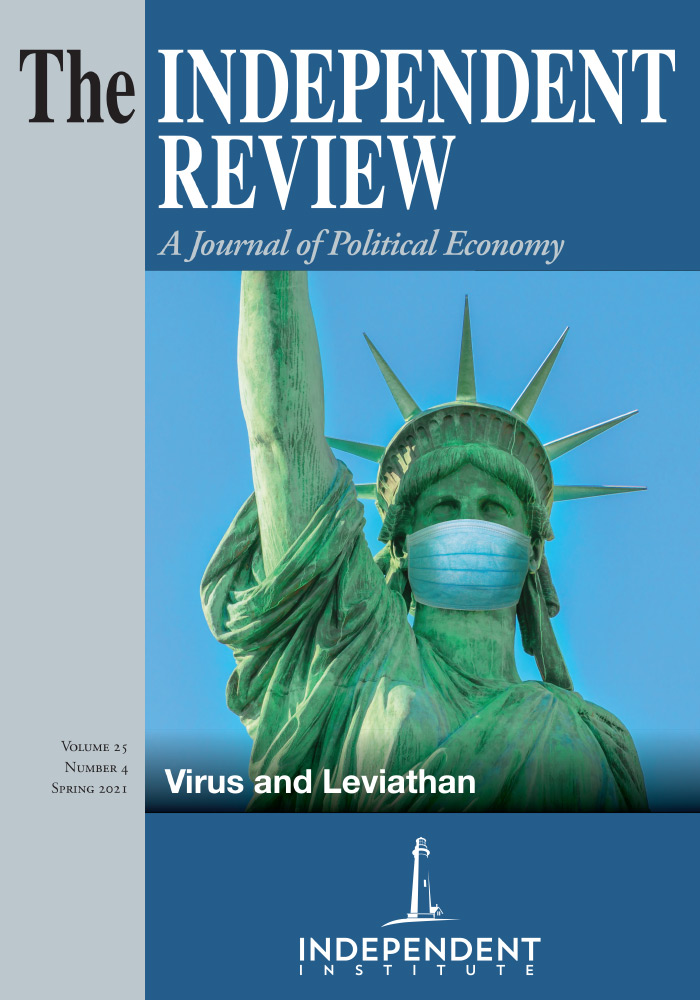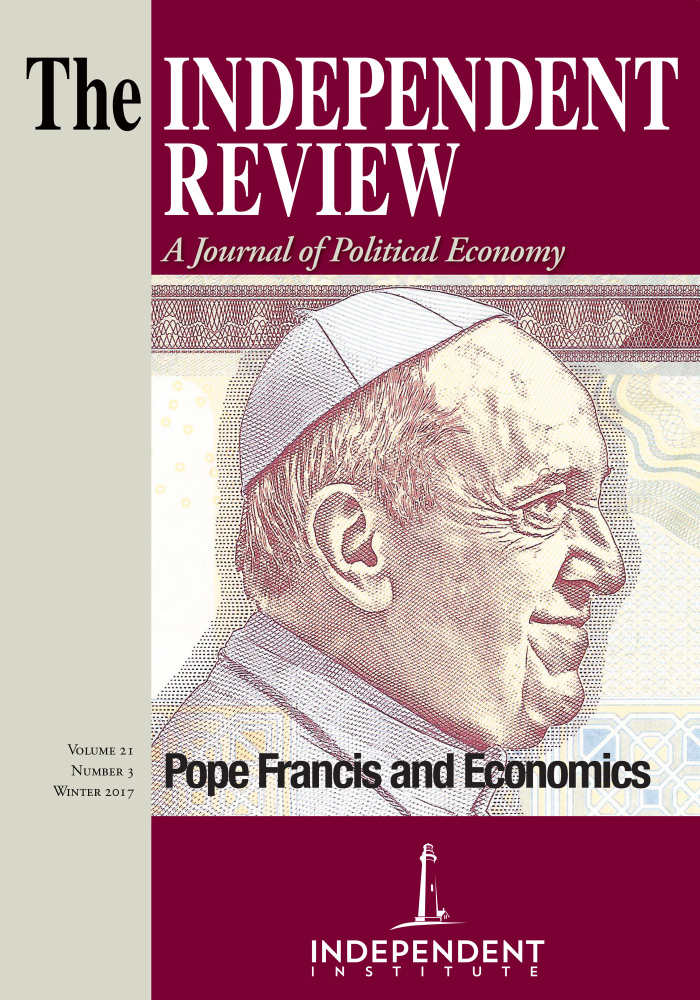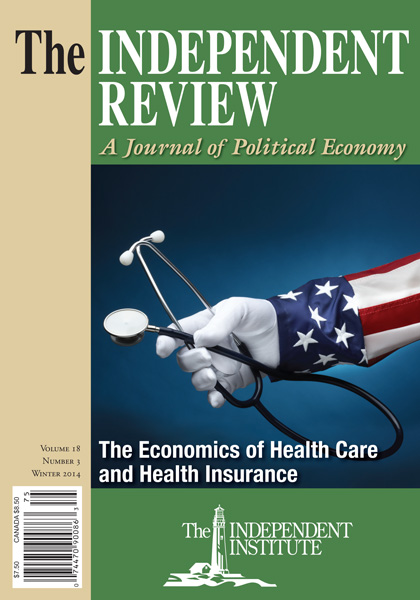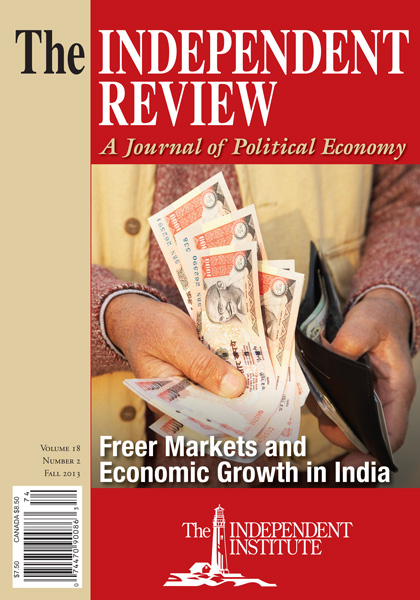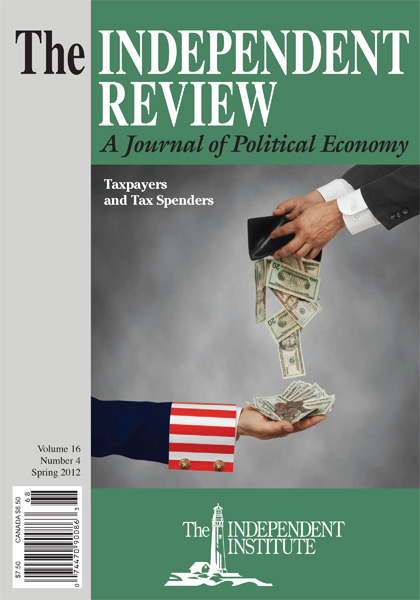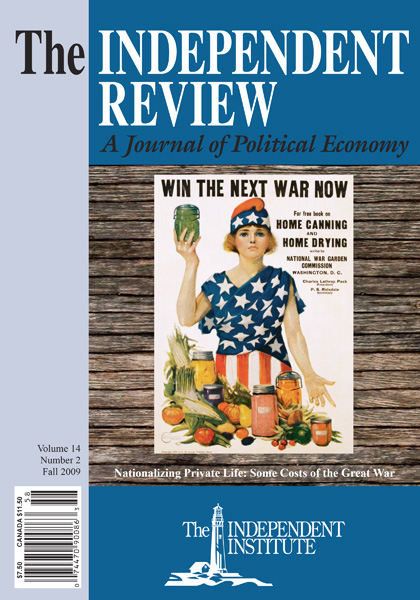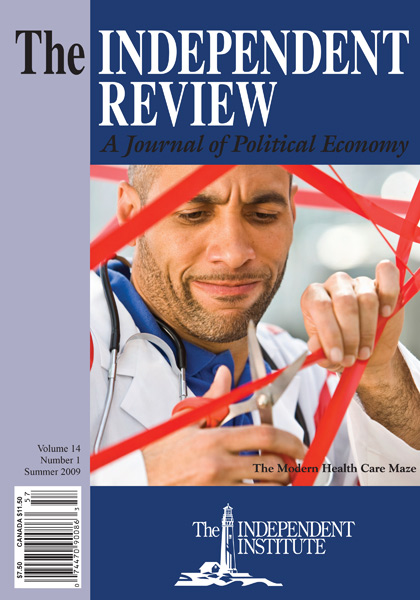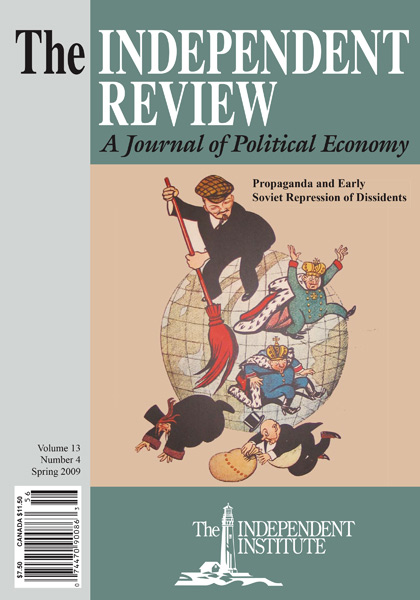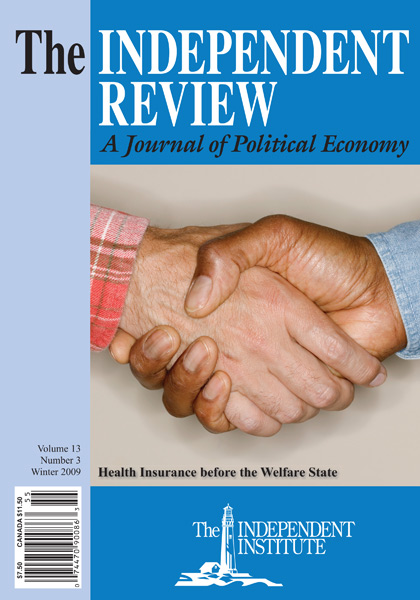Judging by a representative sample of textbooks, America’s high-school students get little exposure to the history of eugenics and scientific racism. One reason might be that the relationship of these movements to Progressivism is too close for comfort.
Article
Eugenics and scientific racism in the United States emerged in the second half of the nineteenth century and lasted through the 1930s. It claimed that heredity was the fundamental determinant of an individual’s ability to contribute to society. Eugenics claimed the scientific ability to classify individuals and groups as “fit” or “unfit.” The unfit were defined by race, mental and physical disabilities, country of origin, and poverty. Eugenics was widely accepted by academics, politicians, intellectuals, government, the U.S. Supreme Court, and especially progressives, who supported eugenics-inspired policies as policy instruments to be utilized by an interventionist administrative state to establish a healthy and productive society. Those who questioned the “settled science” of eugenics were dismissed as “deniers,” much like those who question the “settled science” of climate change are today dismissed as “deniers.”
Eugenics and slavery share much common ground in their inherent racist view of blacks; however, the inherent racist perspective of eugenics was broader in that the set of those considered unfit included individuals and groups beyond those who were black. Eugenics provided the scientific foundation for involuntary sterilization policies in thirty-two states, supported the racist immigration policies in the first part of the twentieth century, and supported a variety of de jure and de facto policies designed to limit those defined as “unfit” to less than full-citizenship status. More troubling, eugenics and eugenics-inspired policies in the United States were admired by Adolf Hitler. American and German eugenicists interacted and exchanged views up to the late 1930s, and sterilization laws, immigration restrictions based on race or ethnicity, and efforts to prevent full citizenship to the unfit in the United States became the model for the Nuremburg Laws of 1935. Stefan Kühl (1994) was the first to document in detail the American–German eugenics connection. In Hitler’s American Model (2017), James Whitman extended this research to illustrate how U.S. policies influenced Nazi race law in the 1930s and the Nuremberg Laws in particular. The Big Lie: Exposing the Nazi Roots of the American Left (2017) by Dinesh D’Souza is the most recent effort to bring public attention to eugenics and the American–German connection.
The widespread acceptance of eugenics in the United States, especially by progressives, is a troubling part of U.S. history unknown to many Americans, and the role model America provided for Nazi race law is even more troubling. The conventional wisdom in the United States places blame for scientific racism on Germany, but the opposite is an inconvenient truth that continues to receive little public attention. The fall of the Third Reich revealed the logical outcome of eugenics. Eugenics disappeared almost overnight from public discourse and became an embarrassment to many who had supported it and its policy implications.
I have covered eugenics and related topics in my lectures on the history of economic ideas for many years and have been surprised at two reactions from students: first, many students find eugenics and related topics the most interesting part of the course, and, second, with only a few exceptions the students have never heard of eugenics in the United States and, especially, its relationship to Nazi Germany. This lack of awareness suggests a question and the catalyst for this paper: To what degree are high school students exposed to the history of eugenics?
One would expect that with the current political focus on discrimination and racism, eugenics would be an important topic in U.S. history and related courses at the high school level. Unfortunately, this is not the case. As I show in this paper, high school history textbooks essentially ignore the topic. Although our high school textbooks are impressive in presentation, length, and number of topics covered, eugenics and its influence on public policy in the United States and its relationship to Nazi Germany are ignored and when mentioned are presented as an incidental part of U.S. history.
I first discuss how eugenics emerged from a combination of the political economy of population growth initiated by Thomas Malthus (1798) and subsequent developments in human biology in the second half of the nineteenth century. Next I discuss how the United States became the center of eugenic research and policy, the relationship between eugenics and the progressive movement, and the degree to which eugenics in the United States influenced Germany and the Nuremburg Laws of 1935. Then I look in particular at nine high school textbooks and other textbook materials to determine the degree to which eugenics is covered in high school. In the concluding section, I offer conjectures to account for the omission and the missed opportunities to educate students resulting from the omission.
Eugenics: Economics, Biology, and the Ideology of Catastrophe
Eugenics-inspired public policy was the outcome of combining two ideas. The first was an economic idea about population growth offered by Thomas Malthus (1798), and the second was a biological idea about human development and behavior offered a century later by Francis Galton (1883), who labeled the biological idea “eugenics” by combining the two Greek words eu, “well,” and genics, “born”: “well born.”
Malthus was not the first to discuss the conflict between the demand for resources to support life and the supply of resources, but he formulated the conflict in such a manner that it had the simplicity of a well-designed “talking point.” According to Malthus, the capacity to reproduce exceeds the capacity to produce food because whereas the former grows geometrically, the latter grows arithmetically; hence, the positive checks that operate on the death rate and the preventive checks that operate on the birth rate are constantly in play, with famine being the ultimate check on population growth. Not only was the idea simple, but it also appeared timely.
Rapid population growth occurred in the early nineteenth century, and the Irish famine from 1845 to 1852 seemed consistent with Malthus’s political economy. The idea became a part of the classical growth model, influenced public policy by making the Poor Laws in England more restrictive, was used as a general argument against any extensive safety net provided by the government, and became a theme in popular literature. In A Christmas Carol, Scrooge responds to a request for a donation to the poor: “If they would rather die they had better do it, and decrease the surplus population” (Dickens 1843, 11).
In the second half of the nineteenth century, however, the Malthusian predictions were increasingly contradicted by reality. Population increased, but economic growth and increased productivity supported the growing population with an increasing real gross domestic product (GDP) per capita worldwide.[1] Nonetheless, Malthus had already opened Pandora’s Box in two ways.
First, concern with population growth combined with the ideology of catastrophe (Bruckner 2012; 2013) had a profound influence on public policy, ranging from the welfare state and unemployment and workers’ compensation insurance to immigration. The ideology of catastrophe is a type of “madness of the crowds” used by advocates of a policy agenda to invoke fear of impending catastrophe unless action is taken immediately and to silence any dissenting views.[2] Second, the Malthusian concern with the quantity of population relative to the resource base could easily be extended to a concern about the quality of population relative to the resource base in terms of the efficiency and productivity of the population.
In On the Origin of the Species (1859), Charles Darwin attributed to Malthus his theory of natural selection and evolution toward improving the quality of any species (introduction). Herbert Spencer (1864) incorporated Darwin in his treatise on biology and coined the phrase “survival of the fittest,” arguing that societies based on the individual in the context of competitive institutions were the strongest and the fittest.[3]
The anxiety first over the quantity of population and then over the quality of population found scientific support in the emerging biology of the human being and human behavior that attempted to identify inherited traits that predicted human behavior. In England, Frances Galton (1883) applied the concept of heredity introduced by Gregor Mendel in the 1860s to human behavior and studied whether different characteristics of human beings and how they influenced behavior were passed on to subsequent generations. In Galton’s view, the quality of the human in terms of contributing to society was not accidental, and because this quality was based on heredity, human behavior could be managed and shaped into producing a better society. Galton called this new science “eugenics.”
Racist views predate eugenics, of course, but eugenics provided the scientific foundation for these racist views and rationalized them as something more than an emotional dislike of others who differ because of color, religion, culture, country of origin, economic standing, mental and physical disability, and so on. Eugenics essentially elevated racism to a virtue in that breeding out the unfit was defined as an expression of concern for improving society.
Eugenics in the United States, Progressives, and the German Connection
The United States became the world’s center for eugenics by the end of the nineteenth century and more than any other country institutionalized scientific racism in its treatment of blacks; immigrants from Asia, eastern Europe, and the Mediterranean; the mentally and physically disabled; and any group deemed to have low potential to contribute to a healthy and productive economy. Eugenics was widely studied as “settled science” at America’s most prestigious educational and research institutions; supported by the Supreme Court (Buck v. Bell 274 U.S. 200 [1927]); widely accepted by prominent politicians such as Woodrow Wilson and prominent academics such as Irving Fisher; and ultimately responsible for the forced sterilization of large numbers of those determined to be “unfit” with the first compulsory sterilization law passed in Indiana in 1907 (Lombardo 2011). Eugenics inspired other public policies to reduce the unfit population—restricted immigration from countries deemed racially inferior, laws against interracial marriage, and de jure and de facto rules to limit citizenship to individuals deemed unfit, such as blacks, low-income individuals, and Jews.
What accounts for the widespread acceptance of eugenics in the United States? Two considerations are important—changing demographics and the emergence of the Progressive movement.
First, significant demographic changes brought large numbers of people deemed racially inferior into competition for resources. After the Civil War, there was considerable fear, especially in the South, that newly freed blacks would integrate into the economic, political, and social life of the nation. Increased immigration at the end of the nineteenth and into the early twentieth century raised similar concerns. Immigrants from Asia, eastern Europe, and the Mediterranean were generally regarded as eugenically unfit. Both demographic events raised concern they would dilute the quality of the population and, if left unchecked, would amount to “racial suicide.”
This view of impending racial catastrophe was captured in The Passing of the Great Race (Grant 1916) and The Rising Tide of Color against the White World Supremacy (Stoddard 1921). Both books and authors played an important role in spreading the message of eugenics—heredity determined one’s ability to contribute to society, and heredity was unchangeable by environment. Madison Grant helped establish the American Eugenics Society (1929–72) to promote eugenics research and provide education programs. Hitler regarded Grant’s book as the “bible” (Kühl 1994, 85) for the coming eugenic cleansing of Germany, and Grant wrote the introduction to Lothrop Stoddard’s book The Rising Tide of Color against the White World Supremacy.
Second, the emerging Progressive movement in the first two decades of the twentieth century elevated eugenics as the foundation for government policy instruments to achieve a healthier and productive society.[4] Birth control, sterilization of the unfit, restrictions on immigration, restrictions on interracial marriage, as well as progressivism’s willingness to ignore anti-Semitism and willingness to keep blacks confined to second-class citizenship status were accepted policies to achieve a better society. Equally important, eugenic-inspired policies and attitudes might not have prevailed to the degree they did without the Progressive movement’s emphasis on science, social planning, and control.
Eugenics and progressivism were made for each other. Eugenics provided the science to categorize individuals as “fit” or “unfit” and thereby was meant to provide a path to a healthier and more productive society. Progressives rejected the invisible hand of the market as the path to a healthy and productive society and instead embraced the visible hand of an interventionist administrative state that based policy on science and experts as the more sure path. Eugenics-inspired policies had to wait for the politics of the large interventionist administrative state (Leonard 2005, 217).
Eugenics and eugenics-inspired policies were an important part of the Progressive movement and show that progressives were not enlightened reformers who protected the weak. In fact, they were just the opposite. Thomas C. Leonard (2003; 2005; 2016) shows how reform-minded economists in the Progressive Era utilized eugenics to rationalize labor and immigration policy. According to Leonard, “Reform-minded economists of the Progressive Era defended exclusionary labor and immigration legislation on the grounds that the labor force should be rid of unfit workers, whom they labeled ‘parasites,’ ‘the unemployable,’ ‘low wage races’ and the ‘industrial residuum’” (2005, 207–8). Minimum-wage legislation was proposed because it paid unfit individuals more than their productivity and thus left them unemployable and less likely to reproduce. Leonard (2016) concludes that progressives were the “illiberal reformers” in the first decades of the twentieth century rather than the enlightened reformers that modern progressives portray them to be.[5] America’s most well-known economist up to that time illustrates this point. Irving Fisher was an “illiberal” reformer who embraced eugenics to counter “race degeneration” and “breed out the unfit and breed in the fit” as a logical extension of his mathematical view of the world (Cox 2005). Fisher was among the founding members of the American Eugenics Society, serving as its president from 1922 to 1926.
The women’s movement aspect of the Progressive Era likewise illustrates the same point. A number of articles in the Birth Control Review (1917–40)[6] reveal racial attitudes common at the time. The Birth Control Review was the journal of the American Birth Control League, founded by Margaret Sanger in 1921 and renamed Planned Parenthood in 1942. Sanger was an advocate of the Malthusian view and eugenics who viewed these perspectives as a foundation to establishing a nation of “thoroughbreds” (Lamb 2015). Attempts (e.g., Kelly 2015) to separate Sanger from the scientific racism of eugenics are not convincing (as argued, e.g., in Mosher 1997; Black 2003, chap. 7; and Schweikart and Allen 2014, 551). Sanger, the Birth Control Review, and the American Birth Control League on the surface appeared focused primarily on birth control but in reality were closely aligned with the broader eugenics movement. Birth control was viewed as only one of many methods society could utilize to reduce the unfit proportion of the population.
Two Birth Control Review articles illustrate Sanger’s broad eugenics perspective and the American–German eugenics interaction by the early 1930s.
Sanger’s article “A Plan for Peace” (1932) proposed a broad plan to reduce the number of the unfit population. She advised the nation to “keep the doors of immigration closed to the entrance of certain aliens whose condition is known to be detrimental to the stamina of the race”; “apply a stern and rigid policy of sterilization and segregation to that grade of population whose progeny is already tainted, or whose inheritance is such that objectionable traits may be transmitted to offspring”; “give certain dysgenic groups in our population their choice of segregation or sterilization”; “take an inventory . . . [of ] illiterates, paupers, unemployables, criminals, prostitutes, dope-fiends, classify them in special departments under government medical protection, and segregate them on farms and open spaces as long as necessary for the strengthening and development of moral conduct” (107–8).
Ernst Rüdin’s article “Eugenic Sterilization: An Urgent Need” (1933), originally published in Germany, focused on the voluntary sterilization of “mental defectives” and recommended a program of propaganda for the general acceptance of sterilization. Rüdinemphasized that the propaganda should be “gradual” and first directed to medical providers. “Individual objections to sterilization need really not be feared where careful explanations and advise are given, consent would, however, be obtained more generally if the operation were offered free of cost to those in poor circumstances” (103). Despite the article’s focus on voluntary sterilization, Rüdin argued that ultimately “there is absolutely no question of using compulsion” (103). He was expressing views that had already been stated many times in the Birth Control Review. The April 1933 issue also included a short summary of developments in Germany regarding sterilization (Hodson 1933, 106).
Rüdin was unlike any other contributor to the Birth Control Review in that he was an internationally recognized German eugenics researcher as well as a strong supporter of Hitler and his policies. He became an official part of the Nazi government’s effort in 1933 “for improvement of the race of the German people” (Kühl 1994, 94), helped form the Nazi government’s forced-sterilization program, and supported the “euthanasia” program in the 1940s, which was directed at the killing of children and mental patients (Joseph and Wetzel 2013). In 1905, Rüdin and others had established the Racial Hygiene Society in Germany. In 1933, the society came under control of the Reich Ministry of the Interior, at which point Minister Wilhelm Frick appointed Rüdin president of the society to work directly with the ministry (Kühl 1994, 94).
Rüdin’s article in Birth Control Review in 1933 and his interest in German sterilization developments represent only one of many examples of the American– German interaction on eugenics. Kühl (1994) argues that historians writing in the 1960s and 1970s and the American Eugenics Society attempted to revise the history of eugenics during the Progressive Era by claiming American eugenics was different from the crude and extreme eugenics of Germany. The evidence suggests otherwise. The eugenics in the United States and the eugenics in Germany in the 1930s is a distinction without much of a difference. America as a nation needs to accept the historical fact that American eugenicists contributed to Germany’s effort to create a society of only fit individuals in what ultimately led down the road to Auschwitz. American eugenics and progressives such as Sanger contributed to building that road even if they ultimately came to reject the logical extension of eugenics in the Third Reich.
Whitman (2017) builds on Kühl’s work and focuses on how eugenics and eugenics-inspired policy in the United States influenced the Nuremburg Laws of 1935: the Reich Citizenship Law and the Law on the Protection of German Blood and German Honor. Whitman takes to task those who deny or minimize such a relationship by claiming that American eugenics policy was not directed toward Jews and that the Nuremburg Laws said nothing about segregation. Whitman dismisses both arguments and emphasizes that the common dominator between America and Germany was the pursuit of a racially purer and healthier society based on the “science” of eugenics via the administrative state. Law was important in the Third Reich even if the objective was the elimination of entire groups of people. Germany wanted to achieve this objective legally[7] and in this regard turned its attention to America’s laws on immigration and mixed marriages as well as to the de jure and de facto U.S. policies that denied blacks and other racially impure groups full citizenship.
Whitman’s research and other research (e.g., Leonard 2009) indicate that the “scientific racism” embedded in eugenics and the progressives’ willingness to embrace eugenics and eugenics-inspired policy reveal the dark side of progressivism. Whitman ends his book with the following comment: “All of these works paint a darker picture of early twentieth-century American intellectual and political life than we might wish. So does this book” (2017, 200).
These are uncomfortable historical facts for the Progressive movement in general and suggest a lack of intellectual balance in, first, how progressives portray their own history; second, how they ignore failures of the administrative state; and third, how they portray nineteenth-century classical liberalism or what is called today the conservative perspective.
Despite the overwhelming evidence that eugenics was an important part of the Progressive movement, progressives continue to ignore their dark history, continue to portray themselves as reformers concerned with the nation’s general welfare, and continue to claim that their policies based on the administrative state and supported by experts have enhanced and will continue to enhance the nation’s general welfare.
Not only are progressives unwilling to confront their own history, but they are also unwilling to recognize the inherent flaw of the administrative interventionist state supported by experts. Progressives offer the administrative state as the solution to economic and social problems but show a remarkable unwillingness to consider the downside of the administrative state revealed by history. This is clearly the case with regard to the Great Depression and the Great Recession,[8] wherein government policy failure played a major role in the economic and financial distress. Eugenics is an even clearer example of government failure. An inherent flaw with the progressive view of the administrative state is the reliance on experts and state power to force individuals to “do the right thing” as determined by the experts. This approach is prone to the same fascism espoused by Hitler and Benito Mussolini (Schapiro 1945). A balanced discussion of progressivism involves considering both the benefits and the costs of the administrative state.
Not only are progressives unwilling to confront their own past or recognize inherent flaws revealed by history in their advocacy of the administrative state, but they also ironically dismiss conservatives as fascists,Nazis, and racists who are insensitive to the weak. In reality, these characterizations applied to progressives and the Progressive movement in the first part of the twentieth century. The progressives in fact were “illiberal” reformers who imposed significant harm on the weak in American society and were willing to exclude large numbers of people from society because so-called experts determined them to be unfit. In contrast to the progressive view, nineteenth-century liberalism offered an enlightened perspective that recognized differences in individuals but had no problem permitting all to compete and take advantage of their comparative advantage in the market place—classical liberalism was inherently nondiscriminatory regarding race, religion, gender, and even sexual orientation in its openness to competition.[9]
In sum, all Americans should face the facts that America was the epicenter of eugenics study; eugenics was an important part of the Progressive movement; and Germany looked to American eugenics as amodel for race-based law.Given this reality, it is worthwhile to see how eugenics is presented to high school students in the United States.
Eugenics and High School History Textbooks
To determine to what degree eugenics is presented to high school students, I examined nine high school textbooks used in U.S. history courses.[10] Each of these textbooks is about eight hundred to one thousand pages long, written by an individual or individuals with advanced degrees who claim to provide a comprehensive overview of U.S. history and policy, and published by a leading textbook publisher. According to the American Textbook Council (2018), Pearson, McGraw-Hill, and Houghton Mifflin are the three major K–12 textbook publishers. Eight of the nine textbooks are associated with these publishers.
The nine books are:
- Thomas A. Bailey, David M. Kennedy, and Lizabeth Cohen, The American Pageant (Boston: Houghton Mifflin, 1998).
- Henry W. Bragdon, Samuel P. McCutchen, andDonald A. Ritchie, History of a Free Nation, Teacher’s Wraparound and Multimedia Edition (New York: Glencoe and McGraw-Hill, 1998).
- John Mack Faragher, Mari Jo Buhle, Daniel Czitrom, and Susan H. Armitage, Out of Many: A History of the American People, Advanced Placement Edition (New Jersey: Prentice Hall, 2002).
- Gary B. Nash, American Odyssey, Teacher Wraparound Edition (New York: McGraw Hill/Glencoe, 2004).
- Andrew Cayton, Elisabeth Israels Perry, Linda Reed, and Allan M. Winkler, America: Pathways to the Present (Needham, Mass.: Pearson/Prentice Hall, 2005).
- Joyce Appleby, Alan Brinkley, Albert S. Broussard, James M. McPherson, and Donald A. Ritchie, The America Vision, Modern Times, Teacher Wraparound Edition (New York: McGraw Hill and Glencoe, 2006).
- Edward L. Ayers, Robert D. Schulzinger, Jesus F. de la Teja, and Deborah Gray White, American Anthem, California Edition (Orlando, Fla.: Holt, Rinehart and Winston, 2007).
- Alan Brinkley, American History (New York: McGraw Hill, 2007).
- Gerald A. Danzer, Jorge Klor de Alva, Larry S. Kreiger, Louis E. Wilson, and Nancy Woloch, The Americans (Boston: McDougal Littell and Houghton Mifflin, 2007).
Three considerations suggest these nine books are a meaningful representative sample of high school history textbooks that provides insight into the degree U.S. students are exposed to scientific racism.
First, there is a difference between high-school-level and college-level textbooks in terms of the level of their exposure to individuals. Virtually every individual in the United States is required to complete a course in U.S. history in high school. High school is the basic educational foundation for the U.S. population, whereas college is not.
Second, the nine textbooks are written by historians with advanced degrees and in some cases extensive publication records and by any reasonable standard reflect topics covered in history courses at the high school level. The textbooks range in publication dates from 1998 to 2007, and even though published more than a decade ago, they still offer a perspective of the degree to which the history of eugenics in the United States is presented to high school students. Textbooks are expensive to publish, and once the textbook outline in the first edition has been established, it becomes somewhat invariant with respect to time; hence, revisions do not occur frequently, and when they do, they are more likely to include new topics rather than revised material up to the time of the revision.[11] In addition, the American Textbook Council (2018) points out that the three major publishers of high school textbooks since 2010 are repackaging earlier textbooks, their emphasis shifting toward more low-content teaching materials emphasizing progressive perspectives.
Third, the nine books are published by the textbook publishers that dominate the high school textbook market in social sciences in the United States. They share a common presentation format; are expensive because of color, visual presentation, and editorial layout; and claim to present a balanced and comprehensive perspective of U.S. history.[12]
I determined the degree to which each of these textbooks devotes attention to eugenics based on two criteria: whether certain headings are included in the index (eugenics, Margaret Sanger, Progressive movement, sterilization, and Buck v. Bell) and the narrative about each of these topics in the textbook.
Sterilization and Buck v. Bell are especially important because they are interrelated, were part of the legal model for German race law, and represent the worst public policies to emerge from eugenics. Sterilization was a logical policy outcome of eugenics. An estimated 60,000 to 70,000 people were forcibly sterilized in the United States. Paul Lombardo’s “Sterilization Legislation Chart, 2017” (2017) indicates that at least 65,370 individuals were forcibly sterilized across thirty-two states from 1907 to 1937. The actual number is likely higher considering that the distinction between forced and voluntary sterilization is a distinction without much of a difference. Buck v. Bell (an eight to one decision written by Justice Oliver Wendell Homes) provided the legal authority for forced sterilization and by any reasonable standard is one of the two worst decisions ever made by the Supreme Court (the other being the Dred Scott v. Sandford decision [60 U.S. 393 (1857)]; see Sullivan 2015). The Nazi defense at the Nuremberg trials cited Buck v. Bell as justification for Germany’s sterilization program administered by Ernst Rüdin.
One caveat should be noted. Even if a reviewed textbook does not include an index heading to eugenics or sterilization, I found a few cases in which the terms are mentioned in the book’s narrative. They are the exception, however. If a specific heading is not included in the index, that is because the authors or the publishers apparently did not regard the topic as relatively important.
Eugenics is referenced in four of the nine textbooks. Out of Many, American Odyssey, The American Vision, and American History devote a paragraph or so to eugenics and most often mention it in the context of immigration policy. None of the reviewed textbooks includes a broad-based discussion of eugenics in the United States.
Margaret Sanger is referenced in six of the nine books and presented as a progressive reformer and advocate of women’s reproductive rights. None of the six textbooks mentions, however, that she was a leading advocate of eugenics or of the racist perspective frequently found in the Birth Control Review.[13]
All but one of the nine textbooks include a relatively long discussion of the Progressive movement. All emphasize the positive contributions made by the Progressive movement; however, a number of textbooks mention its racist attitudes but with the caveat that America was racist in general at the time and that the racism of eugenics did not apply to all progressives. For example, History of a Free Nation states, “Like most white Americans at that time, most progressives believed that nonwhite races were inferior” (642); Out of Many states only that “the more extreme [progressives] . . . embraced the new pseudo-science of eugenics” (620); American Odyssey states, “Few white progressives thought to challenge the racism rampant in American society because they themselves had deeply negative attitudes toward all minority groups” (281); and American History briefly discusses eugenics, sterilization, and immigration restrictions but indicates that these policies had the “support of [only] some of the nation’s leading progressives” (586, emphasis added).
None of the nine books contains an index heading to sterilization despite the fact that thirty-two states had sterilization laws and that sterilization continued well into the twentieth century. American Odyssey mentions forced sterilization as part of the discussion on eugenics but alleges that “some people advocated a eugenics movement, an effort to improve the human race by controlling breeding. The eugenics movement successfully convinced some state legislatures to allow forced sterilization of criminals and individuals who were diagnosed as having severe mental disabilities” (284, emphasis added).
In sum, even though several textbooks include a passing reference to eugenics and sterilization, they do not identify eugenics as a major part of progressivism or the active support of many progressives for the policies advocated by Sanger’s “Plan for Peace.”
None of the nine books indexes Buck v. Bell, whereas eight of the nine textbooks index Dred Scott v. Sandford, and one textbook mentions the case in the narrative. This distinction is remarkable, especially because these textbooks place much emphasis on racism and discrimination in the United States.
The American–German eugenics relationship is not an index heading, and I found no acknowledgment of this interrelationship in the textbooks. A number of the books mention the Holocaust as part of World War II and the Nuremburg Laws, but these references provide no mention of the connection between American eugenics and German eugenics or of the influence that American eugenics and race law had on German race law.
Overall, a high school student reading any of these nine widely used textbooks would be unaware of the following facts: scientific racism was a prominent feature of U.S. history from the late nineteenth century through the 1930s; eugenics was a prominent feature of the Progressive movement; Margaret Sanger played an important role in popularizing and rationalizing eugenics and eugenics-inspired policies; forced sterilization was practiced in a majority of states and supported by the U.S. Supreme Court; and American eugenicists contributed in a meaningful manner to the road Nazi Germany took that ended in Auschwitz. The brief mentions of eugenics and sterilization in a few books are the exception, but even in these cases any student would come away with no meaningful knowledge of the importance of eugenics in U.S. history and government policy. It is possible that some newer textbooks have corrected this problem, but this is unlikely. Unfortunately, I do not have complete access to them, but a review of six recent textbooks available on Amazon provides no evidence to change these findings.[14]
I am surprised and saddened by these findings. A number of the textbooks at least mention the racism of the Progressive movement but attribute that racism to the general racism in the United States of the period, and although a few textbooks mention eugenics and sterilization, they appear to limit its influence to only some progressives. Despite these exceptions, the evidence suggests these widely used textbooks fail to convey the significant role of eugenics in U.S. history and the Progressive movement.
Eugenics has not been entirely ignored in the educational institutions; for example, the nonprofit organization Facing History and Ourselves distributes teaching materials to assist teachers.[15] Compared to the textbooks I examined, the organization’s lesson plans on eugenics are comprehensive in terms of the historical aspects of eugenics, and the references to eugenics, the Progressive movement, Buck v. Bell, sterilization, and the American–German eugenics relationship are impressive. The Facing History and Ourselves materials on eugenics are a step in the right direction; however, they are presented as a collection of topics, each with a short discussion and not well interrelated with other topics. As a result, they cannot serve as a substitute for an overall perspective of eugenics. They do not provide a perspective on the role of eugenics in the Progressive movement, how abortion emerged from the Birth Control League, the eugenic racist views of the Birth Control Review, and America’s significant role in providing a model for Nazi race law. In addition, the usefulness of the topics for the classroom depends on high school teachers’ ability and willingness to incorporate the topics in the classroom. Judged by the nine textbooks and the dominance of progressives in U.S. educational institutions, it is difficult to be optimistic.
Accounting for the Failure to Confront History and Opportunities Thus Lost
Why is eugenics not a significant part of U.S. history, as revealed by these prominent high school textbooks? The following six conjectures are offered to account for the omission.
First, the authors are unaware of eugenics. This conjecture is included here only to cover all possibilities but by any standard is difficult to accept. The authors are educated historians who by any reasonable standard possess a detailed knowledge of the historical events in the United States and world over the past several hundred years. It is difficult to accept that they are unaware of the general outlines of the history of eugenics; in fact, in several cases the textbooks acknowledge the existence of eugenics, scientific racism, and sterilization, but their authors chose to devote only passing attention to these subjects and thus to minimize their importance.
Second, the authors are aware of eugenics but regard it as a relatively unimportant topic relative to other topics. The authors might argue they have only so much space in a textbook and need to prioritize what is treated in detail, treated in passing, or not included. This reasoning is again difficult to accept. Each of the reviewed textbooks is lengthy, some more than one thousand pages long, suggesting that there is room to devote at least a few pages to eugenics. It is hard to accept that a historian regards as relatively unimportant the sterilization of tens of thousands of people in the United States under mandatory laws in force in the majority of states; widespread calls for eliminating the “unfit” via force of one kind or another; calls for what amounts to at best benign concentration camps; the relationship between eugenics and progressivism; or the relationship between the United States and Germany significantly with respect to eugenics. It is especially difficult to accept considering how much attention public education devotes to discrimination and slavery. It is remarkable that none of the textbooks includes Buck v. Bell in its index, whereas all but one of them include Dred Scott. There is obvious common ground between racism against blacks in the United States and the “scientific racism” of eugenics, much of which was directed toward blacks. If discrimination and slavery are deemed important on the stage of U.S. history, then eugenics also deserves some space in the spotlight.
Third, the authors are aware of the history and aware of its importance, but eugenics is like the “crazy uncle” in the progressive family. They are aware of the crazy uncle but uncomfortable discussing the subject in the open. Giving only passing references or no reference to the crazy uncle is more convenient than revealing the inconvenient truth of eugenics in the United States. A variant of this third conjecture is that these textbook authors believe that the Progressive movement’s overall contributions to America more than offset the crazy uncle’s racism and that drawing attention to the crazy uncle distracts students from these positive contributions. Marshall Steinbaum and Bernard Wiesenberger’s (2017) clearly offer this perspective in their critical review of Leonard’s book on eugenics, Illiberal Reformers (2016) (see note 5).
Fourth, Paul Lombardo in private correspondence made the point that state and local school boards play a major role in selecting textbooks and perhaps would rather not discuss the inconvenient truth that their state may have been one of the thirty-two that passed sterilization laws from 1907 to 1937. California led the country in the sterilization program and now accounts for the largest market for high school history textbooks. Textbooks are sensitive to the political environment, so authors are risk averse regarding the inclusion of any material that selection committees might find objectionable. In this regard, Lombardo’s (2017) sterilization legislation chart reveals an important element of the eugenics movement. Republican governors and Republican legislators appear to have represented a higher proportion of supporters than Democrats; however, many Republicans, then as now, are progressives in their reliance on experts and support of a large and interventionist administrative state.
Fifth, progressives dominate U.S. education from the lowest to the highest levels. The common element among progressives, including many Republicans, is the faith in an administrative state supported by experts to guide society to a high level of performance and social justice. Eugenics is the inconvenient truth of the downside of the progressive view and the dangers of permitting so much power in the hands of so few. In this environment, bad ideas can easily become public policy. As such, there is a bias against a balanced presentation of the progressive perspective, especially when a balanced presentation would weaken the case for the progressives’ reliance on the administrative state and reveal the darker side of progressivism.
Sixth, eugenics, scientific racism, sterilization, and the American Birth Control League (now Planned Parenthood) are closely related. The Birth Control Review contains outright racist articles, including a contribution from Ernst Rüdin, who played a major role in Hitler’s sterilization program. The claim that Margaret Sanger was a racist is difficult to reject. Planned Parenthood and abortion are now important progressive institutions and agendas, respectively. Defenders of abortion have attempted to repackage Sanger and claim there is no link between abortion and the eugenics of the progressive movement.
This perspective is astonishing considering the general objective and history of eugenics. Eugenics has always been about influencing the composition of the population to increase the fit/unfit population ratio. Eugenic policies were designed to isolate the unfit (Sanger’s “farms”); to impose rules to limit the unfit population’s full citizenship status; to limit the unfit population through immigration rules; and to lower the birth rate of the unfit through sterilization and birth control. Abortion was not a main feature of the pre–World War II Progressive movement for a variety of reasons. It was an even less important feature of Nazi eugenics (David, Fleischhacker, and H¨uhn 1988). At the same time, however, to claim abortion is not capable of achieving eugenics’ objectives lacks logic, and the willingness to claim that the abortion movement and Planned Parenthood were independent of eugenics and the birth-control movement is remarkable given the existing documented history. Medical technology, medications, Planned Parenthood, social acceptance of abortion by a large percentage of the population and the Supreme Court have elevated abortion as an effective instrument of population control with a eugenic perspective to increase the fit/unfit population ratio. In sum, abortion is closely linked to the objectives of the eugenics movement. The fact that blacks are far more likely as a percent of their population base to have an abortion (e.g., Riley, 2018) makes it difficult to reject the hypothesis that abortion and eugenics are closely linked in terms of purpose. Advances in genetics increase the probability that abortion will increasingly be used to reduce the “unfit” population defined by the woman and her medical provider but influenced by the administrative state through subsidization, information campaigns, and genetic counseling. In this regard, it is worth reading Rüdin’s article published in the Birth Control Review in 1933.
Justice Clarence Thomas’s recent concurring opinion (Thomas 2019) in two Indiana abortion laws recognizes the link and illustrates the sensitivity to any attempt to point out the obvious facts that abortion can be a policy instrument to increase the fit/ unfit population ratio and that abortion law emerged from the eugenics-inspired birthcontrol movement. The hostile reaction to the obvious (e.g., Cohen 2019; Rosenberg 2019) is remarkable in the context of a balanced reading of Justice Thomas’s opinion. The critics “protest too much” and in my opinion fail to consider Thomas’s opinion in the broad context of the history of eugenics and the objectives of eugenics. A careful reading of the opinion in the context of the history of eugenics suggests that the critics are misreading Thomas rather than that Thomas is misreading history, as these critics claim.
Justice Thomas’s opinion is worthy for three reasons: (1) It presents an important history lesson the country needs in the current debate over abortion and is evidence that eugenics and eugenic-inspired policies are again becoming accepted (Wertz 1998; Zigerell forthcoming). (2) It makes the historically correct observation that abortion law grew out of the eugenics movement and does have the potential to be a policy instrument for a eugenics agenda. (3) It is a long overdue effort by a justice of the Supreme Court to mitigate the shame of Buck v. Bell. Not only has Buck v. Bell never been overturned, but the case, along with another decision, is cited in Roe v. Wade (410 U.S. 113 [1973], at 154) to support the Court’s opinion that the right to privacy is not absolute. The Roe v. Wade opinion’s willingness to cite this shameful decision shows the Supreme Court’s lack of sensitivity to the great harm eugenics imposed on society by Buck v. Bell both in the United States and Germany.
Of the six conjectures, the first and second are not credible. The next four are important and offer insight into why eugenics is not a part of the U.S. history presented to high school students. The United States has been steadily moving toward an administrative state structure in which unelected experts play a major role in initiating and implementing public policy. This outcome is not one propelled just by Democrats because there are many Republican progressives who support an administrative state and accept the importance of experts in designing policy. As such, the political correctness so in favor in the United States at this time is not open to a dark history so directly tied to the Progressive movement and so clearly illustrating the adverse impact the administrative state can have on those without political and economic power.
Irrespective of the explanation for omitting eugenics, the omission rules out opportunities to produce an informed public.
First and most obvious, students end up with an incomplete and misleading view of U.S. history, which in turn denies them a foundation to participate in the democratic process. The road from Malthus to Auschwitz had many architects, and unfortunately the United States was a major one. This inconvenient truth is denied to high school students.
Second, a study of eugenics in U.S. history would provide an opportunity to illustrate to students the danger of relying on the “impending crisis,” “the ideology of catastrophe,” and the “settled science” arguments for any agenda. These commonly utilized political arguments increase the probability that disastrous ideas become policy, especially in the context of a large and interventionist administrative state. If textbooks can find space to show how Dred Scott was bad policy that hastened the coming of the Civil War, how can anyone rationalize the omission of Buck v. Bell in those same textbooks?
Third, the history of eugenics in the United States provides perspective on the current debate between socialism and capitalism—that is, the debate whether the collective or the individualistic approach to managing the country is best. It clearly demonstrates the downside of the collectivist approach and of relying on experts, which is the foundation of the various forms of socialism. U.S. history textbooks have no difficulty pointing out the problems of the individualist approach with the many examples of “greed” in the market system but are reluctant to reveal government policy failures such as eugenics. Students need to understand that government policy failure has been at least as much a part of U.S. history as market failure has. Failure to address the costs of the administrative state amounts to nothing less than intellectual dishonesty.
Fourth and last, inclusion of eugenics in school textbooks would provide an important lesson to students on the power of an idea to influence human history, a lesson so eloquently made by John Maynard Keynes in the last paragraph of The General Theory: “[T]he ideas of economists and political philosophers, both when they are right and when they are wrong, are more powerful than is commonly understood. Indeed the world is ruled by little else. . . . I am sure that the power of vested interests is vastly exaggerated compared with the gradual encroachment of ideas. Not, indeed, immediately. . . . [B]ut, soon or late, it is ideas, not vested interests, which are dangerous for good or evil” (1936, chap. 24).
Eugenics, eugenics-inspired policies such as sterilization, and “scientific racism” are bad ideas that in the context of the administrative state brought great harm to large numbers of human beings in the United States, Germany, and elsewhere. Ironically, Keynes was a strong advocate of eugenics and the administrative state.
In closing, the question needs to be asked whether any effort will be made to correct the lack of attention and misrepresentation of scientific racism in the United States, as appears to be the case in high school history. It is easy to be pessimistic, especially given the reaction to Justice Thomas’s opinion and the influence that progressives and teacher unions have over U.S. educational institutions. At the same time, increasing attention is being directed to the history of eugenics, to the close association between eugenics and the progressive movement and to the influence the U.S. eugenics movement had on Nazi Germany. The potential exists for this information to influence public-school teachers who are motivated to present a realistic view of U.S. history, and, even more important, if the movement toward charter schools and vouchers continues, the environment for a balanced presentation of U.S. history would be enhanced. This paper is offered in that hope.
Notes
[1] Bradford DeLong (1998) presents estimates of world GDP from one million B.C. to 1998. Despite Malthus’s warning, world per capita GDP grew after the start of industrialization and has continued to increase.
[2] There is no difference between the enthusiasm for eugenics and the current enthusiasm for climate change in regard to the ideology of catastrophe—both illustrate how advocates utilize impending catastrophe to advance their agenda and silence dissenting views as “deniers” of “settled science.”
[3] Many progressives claim Spencer as the source of the “social Darwinism” feature of classical and nineteenth-century liberal economics; however, this is incorrect and is a myth used by progressives to misrepresent classical economics. The term, in fact, was introduced by Richard Hofstadter ([1944] 1955) as a criticism of classical economics and was not part of classical thought (Leonard 2009).
[4] Historians date the 1920s as the end of the Progressive movement, but in terms of the essence of progressivism the movement continued with the New Deal interventionist policies of the Roosevelt administration in the 1930s and with the slow but steady move toward the administrative state in the postwar period. In fact, the label progressive is increasingly used to describe the liberal perspective.
[5] Marshall Steinbaum and Bernard Weisberger (2017) provide a critical review of Leonard’s Illiberal Reformers, relegating it to “motivated history” that reveals nothing new, fails to appreciate the intellectual evolution of the Progressive movement and the context from which it emerged, and fails to appreciate the Progressive movement’s intellectual contribution to elevate the role of the administrative state supported by expert economists to improve the general welfare. In sharp contrast, Phillip Magness (2017) reviewed Steinbaum and Weisberger’s “review essay” and found that it fell “short of reasonable scholarly standards,” failed to confront Leonard’s evidence, and failed to address Leonard’s main point about the administrative state; in sum, he says, the “review essay” amounts to mainly an endorsement of the Progressive movement’s contribution to general welfare.
Steinbaum and Weisberger’s review essay does in fact fall short of reasonable scholarly standards, and its main contribution is to serve as an illustration of progressives’ insensitivity to the collateral damage inflicted by an interventionist administrative state on those without economic and political power.
Bradley Bateman’s review of Illiberal Reformers criticized Leonard for not devoting attention to economists who were not eugenicists, but it nonetheless found Leonard’s contribution important. According to Bateman, “The story of progressivism will never be told exactly the same way again. . . . There is a dark side to progressive thinking that must be fully acknowledged and reckoned with” (2017, 718).
[6] Issues of the Birth Control Review can be found online here.
[7] The Wannsee Protocol (1942) emphasized the complete elimination of Jews from German living space “in a legal manner.” The dramatization of the Wannsee Conference in the 2001 movie Conspiracy emphasizes the Germans’ desire to base the Holocaust on a legal foundation.
[8] Progressives continue to present the Great Depression as an example of market failure mitigated by the administrative state, when in fact research suggests that government policy failures played a major role in causing and prolonging the Great Depression (e.g., Miller and Rose 1983; Cargill and Mayer 1998, 2006; Bernanke 2002; Cargill 2011). The same argument can be made for the progressive view of the Great Recession.
[9] Critics dismiss classical economics as the “dismal science” and an attack on the weak; however, this phrase and its implication are misrepresentations of the intellectual content of classical economics (as clarified, e.g., in Persky 1990 and Levy 2001; 2005).
[10] The nine books were provided to me by Jennifer Jurosky, a social science teacher at North Tahoe High School, Tahoe City, California, in connection to a project on teaching economics in Washoe County High Schools (Cargill, Jurosky, and Wendel 2008).
[11] Adam Shoda, a faculty member at Galena High School in Reno, Nevada, informed me that the 2007 edition of The Americans (number 9) is still used for history classes.
[12] I also reviewed Larry Schweikart and Michael Allen’s book A Patriot’s History of the United States (2014) for this paper but did not include in the sample of textbooks because it would likely not appeal to high school selection committees because of its emphasis on the exceptionalism of the United States.
[13] Schweikart and Allen conclude that “Sanger revealed herself as a full-fledged racist” and reference the “proeugenics” articles published in the Birth Control Review (2014, 551). Despite these references, even they do not present a broad discussion of eugenics.
[14] One reader of an earlier version of this paper suggested using Amazon’s “Look Inside” feature to see whether other history textbooks reference eugenics. Taking up this suggestion, I “looked inside” five U.S. history books written by Howard Zinn ([1980] 2003), Steve Wiegand (2014), Lily Rothman (2016), George Lee (2017), and Sterling Education (2019) and used Google Books’ search feature to “look inside” a book by Wilfred McClay (2019). Five of the six textbooks are recent publications. Eugenics is not mentioned in five of the six books and only once in McClay. Even there it is not discussed but only mentioned in passing as part of a quote from a textbook used by the biology teacher John Scopes in State of Tennessee v. John Thomas Scopes (1925). Sterilization and Buck v. Bell are not mentioned in any of the six books. These results are consistent with the review of the nine textbooks; however, the results are limited because they depend on the search engines and because some of the books are not designed specifically for high school history.
[15] See the Facing History and Ourselves website.
References
American Textbook Council. 2018. Widely Adopted History Textbooks.
Bateman, Bradley W. 2017. Book Review: Illiberal Reformers: Race, Eugenics, and American Economics in the Progressive Era. History of Political Economy 49, no. 4: 717–21.
Bernanke, Ben S. 2002. On Milton Friedman’s Ninetieth Birthday. Federal Reserve Board, November 8.
Black, Edwin. 2003. War against the Weak: Eugenics and America’s Campaign to Create a Master Race. Washington, D.C.: Dialog.
Bruckner, Pascal. 2012. The Ideology of Catastrophe. Wall Street Journal, April 10.
———. 2013. The Fanaticism of the Apocalypse. Translated by Steven Rendall. Malden, Mass.: Policy Press.
Cargill, Thomas F. 2011. Meltzer’s History of the Federal Reserve: A Review Essay. International Finance 14, no. 1: 183–207.
Cargill, Thomas F., Jennifer Jurosky, and Jeanne Wendel. 2008. Implementing Economics Standards: A Pilot Transition Program. Journal of Economic Education 39, no. 2: 126–34.
Cargill, Thomas F., and Thomas Mayer. 1998. The Great Depression and History Textbooks. The History Teacher, August, 441–58.
———. 2006. The Effects of Changes in Reserve Requirements during the 1930s: The Evidence from Nonmember Banks. Journal of Economic History 66, no. 2 (June): 417–32.
Cohen, Adam. 2019. Clarence Thomas Knows Nothing of My Work. Atlantic, May 29.
Cox, Annie. 2005. “Breed Out the Unfit and Breed in the Fit”: Irving Fisher, Economics, and the Science of Heredity. American Journal of Economics and Sociology 64, no. 3 (July): 793–826.
Darwin, Charles. 1859. On the Origin of the Species. A Pennsylvania State University Electronic Classics Series Publication.
David, Henry P., Jochen Fleischhacker, and Charlotte Hohn. 1988. Abortion and Eugenics in Nazi Germany. Population and Development Review 14, no. 1 (March): 81–112.
De Long, J. Bradford. 1998. Estimates of World GDP, One Million B.C.–Present 1998. Manuscript, Department of Economics, University of California, Berkeley.
Dickens, Charles. 1843. A Christmas Carol.
D’Souza, Dinesh. 2017. The Big Lie: Exposing the Nazi Roots of the American Left. Washington, D.C.: Regnery.
Galton, Francis. 1883. Inquiries into Human Faculty and Its Development. London: Dent.
Grant, Madison. 1916. The Passing of the Great Race. New York: Scribner’s.
Hodson, Cora B. S. 1933. An Instrument in Race Progress. Birth Control Review, April, 105–6.
Hofstadter, Richard. [1944] 1955. Social Darwinism in American Thought. Boston: Beacon Press.
Joseph, Jay, and Norbert A. Wetzel. 2013. Ernst Rüdin: Hitler’s Racial Hygiene Mastermind. Journal of the History of Biology 46: 1–30.
Kelly, Amita. 2015. Fact Check: Was Planned Parenthood Started to “Control” the Black Population? National Public Radio, August 14.
Keynes, John Maynard. 1936. The General Theory of Employment, Interest, and Money. London: Palgrave McMillan.
Kühl, Stefan. 1994. The Nazi Connection: Eugenics, American Racism, and German National Socialism. New York: Oxford University Press.
Lamb, W. Scott. 2015. Margaret Sanger Wanted a Race of Thoroughbreds. Washington Times, July 21.
Lee, George. 2017. U.S. History, People, and Events, 1865–Present. New York: Mark Twain Media.
Leonard, Thomas C. 2003. More Merciful and Not Less Effective: Eugenics and Progressive-Era American Economics. History of Political Economy 64, no. 3: 757–91.
———. 2005. Eugenics and Economics in the Progressive Era. Journal of Economic Perspectives, Fall, 207–24.
———. 2009. Origins of the Myth of Social Darwinism: The Ambiguous Legacy of Richard Hofstadter’s Social Darwinism in American Thought. Journal of Economic Behavior & Organization 71: 37–51.
———. 2016. Illiberal Reformers: Race, Eugenics, and American Economics in the Progressive Era. Princeton, N.J.: Princeton University Press.
Levy, David M. 2001. How the Dismal Science Got Its Name: Debating Racial Quackery. Journal of the History of Economic Thought 23 (March): 5–35.
———. 2005. How the Dismal Science Got Its Name. Ann Arbor: Michigan University Press.
Lombardo, Paul A., ed. 2011. A Century of Eugenics in America. Bloomington: Indiana University Press.
———. 2017. Sterilization Legislation Chart, 2017. Unpublished. Copy in author’s files.
Magness, Phillip W. 2017. The Progressive Legacy Rolls On: A Critique of Steinbaum and Weisberger on Illiberal Reformers. Econ Journal Watch, January, 20–34.
Malthus, Thomas. 1798. An Essay on the Principle of Population. London: Johnson.
McClay, Wilfred M. 2019. Land of Hope: An Invitation to the Great Story. New York: Encounter Books.
Miller, Stephen L., and Stephen A. Rose. 2003. The Great Depression: A Textbook Case of Problems with American History Textbooks. Theory and Research in Social Education 11 (Spring): 25–39.
Mosher, Steven. 1997. The Repackaging of Margaret Sanger. Wall Street Journal, May 5.
Persky, Joseph. 1990. Retrospectives: A Dismal Romantic. Journal of Economic Perspectives 4 (Fall): 165–72.
Riley, Jason L. 2018. Let’s Talk about the Black Abortion Rate. Wall Street Journal, July 10.
Rosenberg, Ili. 2019. Clarence Thomas Tried to Link Abortion to Eugenics: Seven Historians Told the Post He’s Wrong. Washington Post, May 30.
Rothman, Lily. 2016. Everything You Need to Know to Ace American History in One Big Fat Notebook. New York: Workman.
Rüdin, Ernst. 1933. Eugenic Sterilization: An Urgent Need. Birth Control Review, April, 102–4.
Sanger, Margaret. 1932. A Plan for Peace. Birth Control Review, April, 107–08.
Schapiro, J. Salwyn. 1945. Thomas Carlyle, Prophet of Fascism. Journal of Modern History 17, no. 2 (June): 97–115.
Schweikart, Larry, and Michael Allen. 2014. A Patriot’s History of the United States. New York: Sentinel.
Spencer, Herbert. 1864. Principles of Biology. London: Williams and Norgate.
Steinbaum, Marshall I., and Bernard A. Weisberger. 2017. The Intellectual Legacy of Progressive Economics: A Review Essay of Thomas C. Leonard’s Illiberal Reformers. Journal of Economic Literature 55, no. 3: 1064–83.
Sterling Education. 2019. Everything You Always Wanted to Know about American History. Boston: Sterling Test Prep.
Stoddard, Lothrop. 1921. The Rising Tide of Color against White World Supremacy. New York: Scribner’s.
Sullivan, Casey C., Esq. 2015. 13 Worst Supreme Court Decisions of All Time. FindLaw, October 14.
Thomas, Clarence. 2019. Concurring Opinion in Box v. Planned Parenthood.
Wannsee Protocol. 1942. January 20. Holocaust Research Project.
Wertz, Dorothy C. 1998. Eugenics Is Alive and Well: A Survey of Genetic Professionals around the World. Science in Context 11, nos. 3–4: 493–510.
Whitman, James Q. 2017. Hitler’s American Model: The United States and the Making of Nazi Race Law. Princeton, N.J.: Princeton University Press.
Wiegand, Steve. 2014. U.S. History for Dummies. New York: Wiley.
Zigerell, L. J. Forthcoming. Understanding Public Support for Eugenic Policies: Results from Survey Data. Social Science Journal. Available online as of February 19, 2019
Zinn, Howard. [1980] 2003. A People’s History of the United States. New York: Harper Collins.

